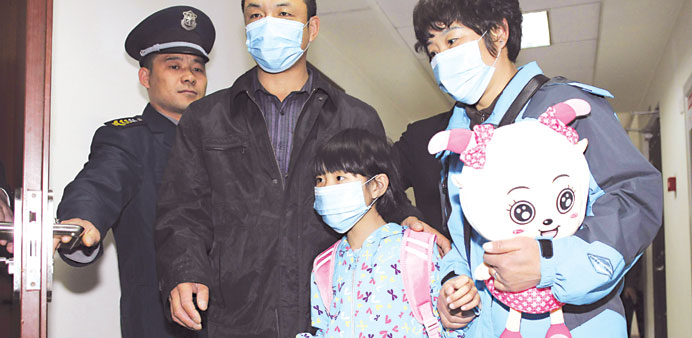A girl, who was confirmed as the first person in the Chinese capital to be infected with the H7N9 strain, arrives for a news conference in Beijing yesterday.
Reuters/Geneva/Beijing
The World Health Organization said yesterday that a number of people who have tested positive for a new strain of bird flu in China have had no history of contact with poultry, adding to the mystery about a virus that has killed 16 people to date.
Chinese authorities have slaughtered thousands of birds and closed some live poultry markets to try and stem the rate of human infection, but many questions remain unsolved, including whether the H7N9 strain is being transmitted between people.
WHO spokesman Gregory Hartl confirmed that “there are people who have no history of contact with poultry”, after a top Chinese scientist was quoted as saying about 40% of those with the H7N9 flu had had no such contact.
“This is one of the puzzles still (to) be solved and therefore argues for a wide investigation net,” Hartl said in e-mailed comments, though he did not know the exact percentage.
Hartl said several avenues should be explored by an international team of experts going to China soon, including the possibility that the virus can be spread between people, although there is “no evidence of sustained human-to-human transmission”.
“It might be because of dust at the wet markets, it could be another animal source beside poultry, it could also be human-to-human transmission,” he said by telephone.
Wendy Barclay, an influenza expert at Imperial College London, said it was likely to be very difficult to determine or rule out people’s exact exposure to poultry - or to wild birds, which could also be a possible source of infection.
“The incubation time might be quite long, so visiting a market even 14 days before might have resulted in infection,” she said.
Two new suspected cases of possible human-to-human transmission are being investigated, Hartl said.
The first is a couple in Shanghai who tested positive, Hartl said, adding that the wife had died and husband was still sick. A seven-year-old girl in Beijing was the first case in the capital at the weekend and the boy next door has also tested positive, but is not showing symptoms.
Previously the WHO reported two suspected family “clusters”, but later said the virus was found not to have infected anyone in the first. Tests in the second were inconclusive and experts say the poor quality samples may make it impossible to know.
China has warned that the number of infections could rise from the current 77. The majority of the cases have been in China’s commercial capital Shanghai, the official Xinhua news agency said on Tuesday.
China reported three new bird flu outbreaks to the World Animal Health Organisation (OIE) this week, bringing the total number of places to 11, the OIE said on its website.
Samples have tested positive in some poultry markets that remain the focus of investigation by China and the UN’s Food and Agriculture Organization.
Zeng Guang, the chief scientist in charge of epidemiology at the China Disease Prevention and Control Centre (CDPCC), said about 40% of human victims had no clear history of poultry exposure, the Beijing News reported yesterday.
A study published last week showed the H7N9 strain was a so-called “triple reassortant” virus with a mixture of genes from three other flu strains found in birds in Asia.
One of those three strains is thought to have come from a brambling, a type of small wild bird.
“We can’t rule out that this ... has passed through poultry but then been reintroduced to a wild bird population from which some spread to humans might be occurring,” Barclay said.
China’s poultry sector has recorded losses of more than 10bn yuan ($1.6bn) since reports emerged of the strain two weeks ago, while authorities have slaughtered thousands of birds and closed live poultry markets in Shanghai and Beijing.
China said on Sunday the virus had spread outside the Yangtze River delta region in eastern China, with cases reported in Beijing and the central province of Henan.
Beijing H7N9 bird flu victim leaves hospital
A seven-year-old girl who contracted the H7N9 strain of bird flu left hospital yesterday and appeared before media in an apparent bid by health authorities to cool concerns about the deadly virus.
The daughter of poultry traders was Beijing’s first confirmed human case of the virus, which has killed 16 people and infected scores of people hundreds of kilometres away in eastern China over the past few weeks.
Wearing a bright blue coat and pink backpack, she said she was feeling “much better”, at a press conference held by hospital authorities.
“I miss home... I want to return home and play,” she told AFP.
She wore a face mask, in what hospital authorities said was a measure to protect her identity rather than her health.
They said that she recovered after seven days of treatment combining Western and Chinese medicine. No vaccine to protect against the virus currently exists.
The girl’s mother and father, who had been quarantined for observation, left hospital with their daughter.

